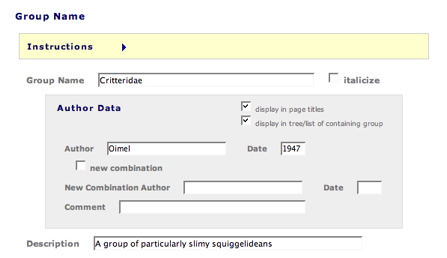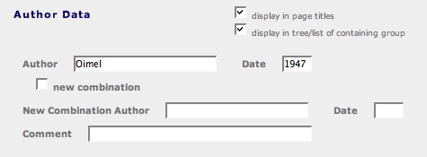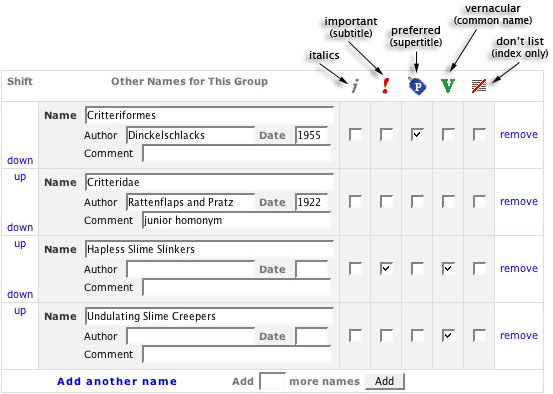ToL Web Tools: Taxon Names
The Taxon Names form lets you specify the name of your taxon, along with related information including authorship data, a taxon descriptions, and other names used for the taxon.
Name
By default, the Group Name is used as the title for your branch
or leaf page and as the name that is displayed in the tree or taxon list
of the containing group. Please enter only plain text in the Group
Name field, i. e., don't use HTML code. If you want the group name
to be displayed in italics, check the italicize box. This box
is selected by default on leaf pages.
When naming a group in the Tree of Life, you will usually want to use the valid, scientific name for the entire group. However, in the case of prominent groups that have a widely used common name (e.g., Green Plants or Animals), this name may be a better choice, especially if several scientific names have been proposed, but none of them has been accepted universally. If a group does not (yet) have a formal, scientific name, you can circumscibe the group in plain language, e. g., Western Palearctic water frogs. Here are a few additional guidelines on the choice of group names:
- Do not use names that refer only to some part of your group (e.g., not "Basal Coleoptera")
- Do not include information on ranks in your group name (e.g., not "Order Coleoptera")
- In the case of subgenera or subspecies, use the full name, not just the name referring to the subtaxon (e.g., Rhyzodiastes (Rhyzostrix) rather than just Rhyzostrix).
- Always use the most specific scientific name available for a group;
i. e., in the case of a monotypic genus, use the name of the species,
not the name of the genus as the node name. If you
would rather use a higher taxonomic category as the principal name
for your group, have a look at the preferred label
 option in the Other Names
Instructions below. The Other Names list also lets you designate
important names
option in the Other Names
Instructions below. The Other Names list also lets you designate
important names  ,
which will be printed as subtitles on the ToL page.
,
which will be printed as subtitles on the ToL page.
Authors
 Entering author
data for names is optional. Please use only four-digit numbers for the
Date entry. If you want to have these data displayed on ToL pages,
you need to select one or both of the display in ... boxes at
the top.
Entering author
data for names is optional. Please use only four-digit numbers for the
Date entry. If you want to have these data displayed on ToL pages,
you need to select one or both of the display in ... boxes at
the top.
If the taxon name constitutes a new combination, check the new combination box to have the original author data printed in parentheses. You can also provide information about the New Combination Author. If both author and new combination author are provided and the display in ... box is selected, the name of the new combination author will be printed after the name of the original author, i. e., Taxon Name (Author Date) New Combination Author Date.
The Comment field allows you to provide additional information, e. g., in ..., nec..., sensu..., partim..., emend..., etc., which will be printed after the author data.
Description
The Description field can be used to provide information that may make it easier for non-specialists to recognize or interpret a given group of organisms. For example this field can contain a brief description of the kinds of organisms contained within the group or a list of well-known subgroups.
Examples of information that may be provided in the Description field:
- a brief description of the kinds of organisms contained within the
group, e. g.:
- name = Vampyrellids, description = (fungus- and algae-eating protists)
- name = Rana (Pelophylax), description = (A group of water-bound frogs inhabiting Eurasia)
- a list of well-known subgroups, e. g.:
- name = Basidiomycota, description = (mushrooms, rusts, smuts, etc.)
- name = Therapsida, description = (mammals and their extinct relatives)
In the current default version of the Tree of Life, descriptions are printed together with the taxon name in the tree or list of taxa on the page of the containing group, e. g.:

Description entries should therefore be rather brief. Common names or other alternative names for a group can be used in descriptions, but these names should also be entered in the Other Names list, so that they will be available in taxon searches.
Other Names
The Other Names list should be used to store information about
other names that apply to the group as a whole. These other
names can be synonyms, common names, or names representing different
taxonomic ranks in the case of monotypic taxa where two or more ranks
refer to the same group of organisms. You can also provide information
about the author for each name.
Check the italicize box  ,
if a name should be displayed in italics. Mark
common names by checking the vernacular box
,
if a name should be displayed in italics. Mark
common names by checking the vernacular box  . Check
the don't list box
. Check
the don't list box  ,
if a name should not be listed in the Other Names section of the page.
The name will then only be used in the ToL names index, so people using
the name in a group search will be guided to the relevant page.
,
if a name should not be listed in the Other Names section of the page.
The name will then only be used in the ToL names index, so people using
the name in a group search will be guided to the relevant page.
If you designate one or more of the names as important names
 ,
these names will be displayed in the subtitle of the ToL page. If you
designate one or more of the names as preferred labels
,
these names will be displayed in the subtitle of the ToL page. If you
designate one or more of the names as preferred labels  ,
these names will be displayed in the supertitle of the ToL page. Also,
preferred labels are used instead of the group name to represent
the taxon in the tree or list on the page for the containing group. The
preferred label option is particularly useful in the case of
monotypic taxa, where the group name should be the name of the lowest
taxonomic rank, but the name of a higher taxonomic rank can become the
prominent name on ToL pages if it is designated as the preferred label.
,
these names will be displayed in the supertitle of the ToL page. Also,
preferred labels are used instead of the group name to represent
the taxon in the tree or list on the page for the containing group. The
preferred label option is particularly useful in the case of
monotypic taxa, where the group name should be the name of the lowest
taxonomic rank, but the name of a higher taxonomic rank can become the
prominent name on ToL pages if it is designated as the preferred label.
Click on Add another name to get a blank set of fields for a new entry. You can also add several sets by entering the number you want in the field and clicking on the Add button. Change the sequence of names in the list by clicking on up or down in the left-hand column. Delete a name from the list by clicking on remove in the right-hand column.
 Go to quick links
Go to quick search
Go to navigation for this section of the ToL site
Go to detailed links for the ToL site
Go to quick links
Go to quick search
Go to navigation for this section of the ToL site
Go to detailed links for the ToL site